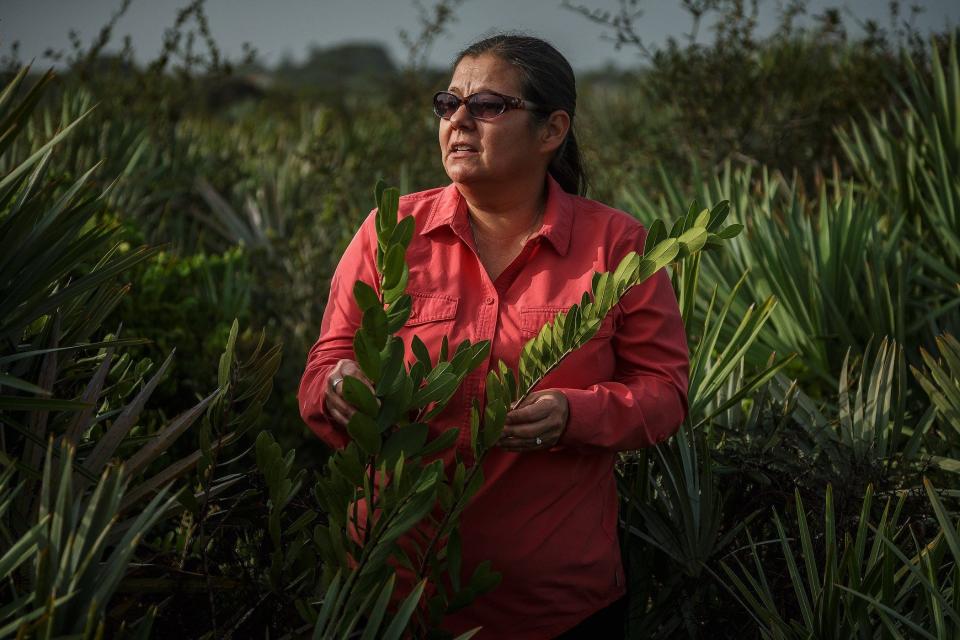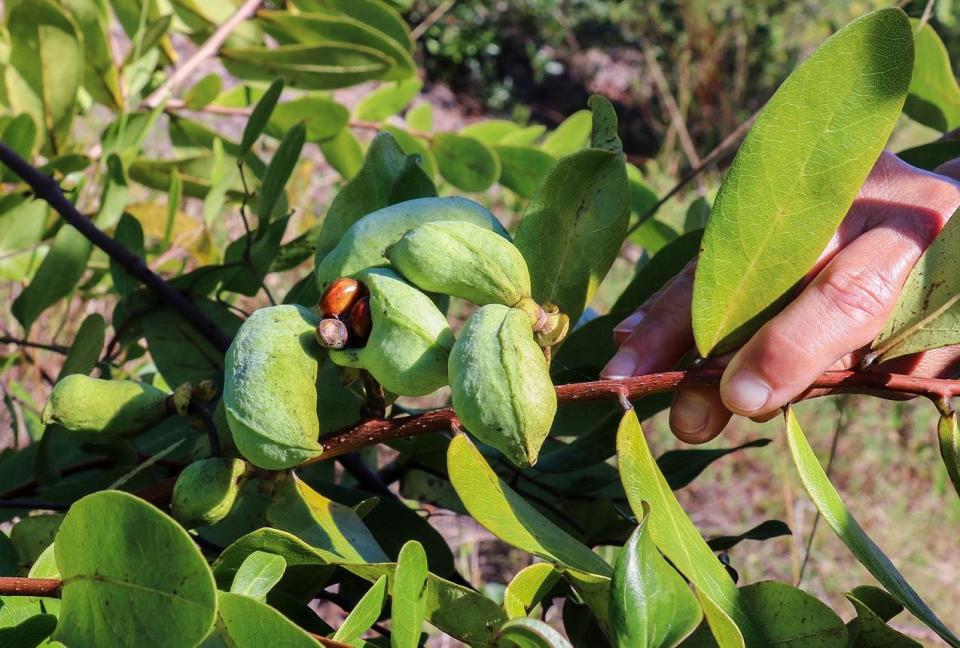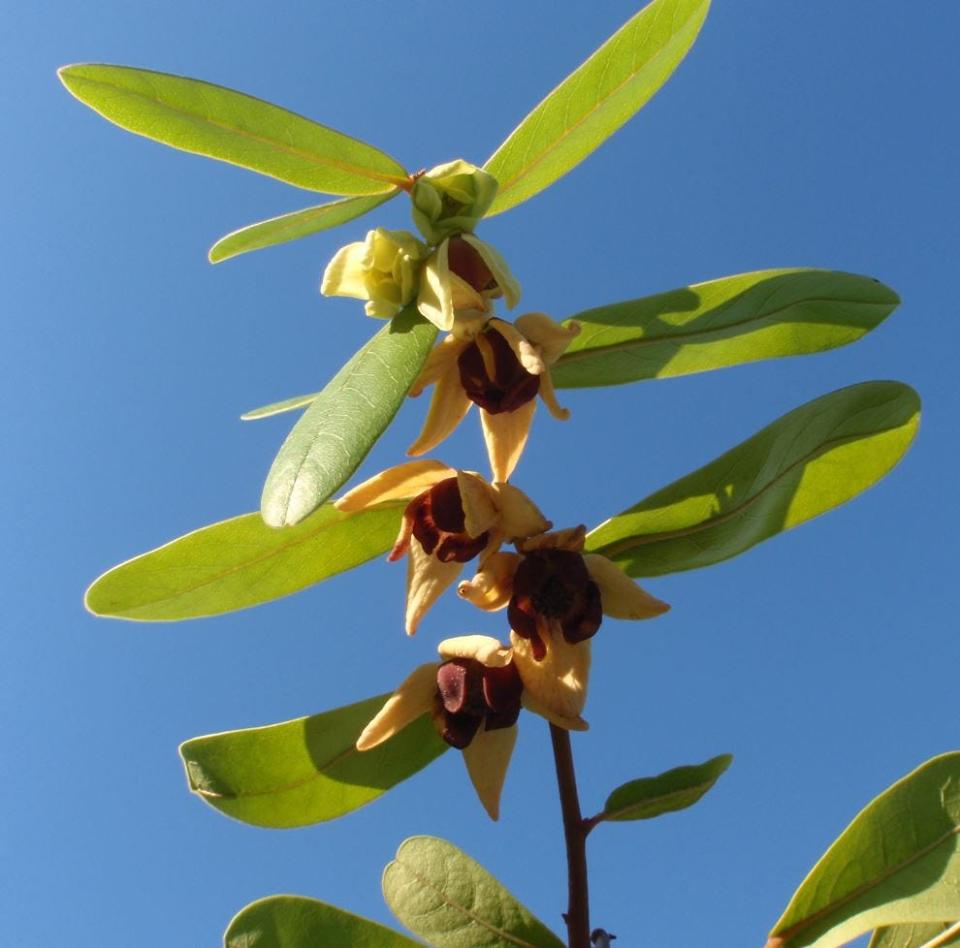The last of the four-petal pawpaw plants are in South Florida and need help to survive
Along a Pleistocene epoch sand ridge in Juno Beach is an unassuming shrub so rare it grows only in Palm Beach and Martin counties — its cream and maroon-colored flowers likely overlooked by most passersby.
The federally endangered Asimina tetramera, or four-petal pawpaw plant, provides fruit for the gopher tortoise, is a host to zebra swallowtail butterfly larvae and offers a bloom that either reeks of feces, yeast, rotten fruit or wafts the more pleasant earthy scent of root beer.
In all the world, it has been reduced to about a 35-mile strip of high and dry coastal sand pine scrub habitat from near Jensen Beach in Martin County to the Lake Park Scrub Natural Area north of West Palm Beach.

With its habitat scraped and discarded for homes, condos and shopping plazas, there are believed to be just 1,400 plants left in the wild, according to a 2022 report by the U.S. Fish and Wildlife Service. The plant was listed as endangered in 1986.
Fragile plant needs very specific conditions to thrive
“It’s a bit of a Goldilocks plant,” said Melissa Tolbert, Palm Beach County’s environmental program supervisor for its Department of Environmental Resources Management.
Crested caracara in trouble: Everglades restoration threatens population of rare raptors
It likes a little shade, but not too much shade. It needs periodic fires to clear away surrounding overgrowth and trigger re-sprouting. It prefers beetles — scarab and longhorn — for pollination, doesn’t like invasive plants as neighbors and needs well-drained sandy soil to sink its tap root up to 8 feet deep.
It blooms in the spring and has soft green leaves. But in the winter, it goes dormant, looking more like a stick than the type of evergreen plant more common in scrub habitat.
There are few plants on private land, and while the four-petal pawpaw is believed to live for up to a century, the 2022 report says no new populations have been discovered in at least 12 years.
Desperate plea to save the largely unknown pawpaw
"All factors indicate that Asimina tetramera has a tenuous hold in the miniscule remaining habitat to which it is adapted," wrote biologist Richard Moyroud in a 1985 letter lobbying for the four-petal pawpaw to be listed as endangered.
Moyroud said the flora was struggling to exist in areas where people were dumping trash, changing their cars' oil, and carving baseball fields and walking trails through fragile terra firma.

"I have communicated my concern to county parks officials, but in this region of extreme growth, volatile and often irrational political decisions are compounded by the attitude of some current elected officials," Moyroud wrote.
He said plants near county parks are "doomed" by development. Those within county parks are threatened by people wanting to turn them into recreational facilities with tennis courts, paved parking and fences.
County officials working hard to maintain population of pawpaws
Palm Beach County has more than half of the 1,400 known plants dispersed among its untouched landscapes, including Juno Dunes Natural Area, the Karen Marcus Ocean Park Preserve and the Pawpaw Preserve — a tiny 3-acre scratch of saw palmetto and scrub oaks north of PGA Boulevard.
“As long as we can still do prescribed burns and control exotics, it has nothing but room to grow in our preserve areas,” said TJ Wilkerson, the manager for Juno Dunes Natural Area, which has about 500 four-petal pawpaw plants.

But the 2022 report notes that plant's recovery potential is “low.”
The four-petal pawpaw is a member of a large, mainly tropical plant family that includes other shrub-like species. It shouldn’t be confused with the pawpaw tree, which can withstand cooler climates, but has a similar fruit that looks like a small mango. A Cornell College of Agriculture and Life Sciences paper from 2018 says the fruit of the pawpaw tree tastes similar to a banana.
Wilkerson confirmed the fruit of the four-petal pawpaw plant smells like a banana, but he said he hasn’t tasted it. In addition to the gopher tortoise, mice eat the fruit, helping spread the seeds and germinate new plants.
“I was enthralled by this plant, maybe enslaved is a better word, since the first time I saw it,” said Anne Cox, a scrub biologist in Stuart who completed her dissertation on the pawpaw. "The more I learned, the more curious I became."
Amazing discovery in Palm Beach County: Giant manta ray babies and a study that could save a threatened species
Cox, who is 82 years old, has studied the four-petal pawpaw for 40 years. She first came across the plant in the late 1980s at the Florida Power & Light Co. facility in Juno Beach. There were 61 plants there in a 2006 survey, but that had dwindled to 23 in 2021, according to the USFWS report.
The pawpaw is an anomaly in the scrub with its deciduous leaves, as opposed to hardened foliage adapted to prevent moisture loss. Although researchers have tried to grow the four-petal pawpaw in labs and transplant them to suitable landscapes, they don’t do well with the transition and can be finicky about their habitat. Seeds planted by Cox in 2001 in the wild didn’t bloom for 20 years, she said.

“You just can’t plant it anywhere,” Cox said. “Like many other endangered animals and plants, they are complicated, and there is no one simple answer a lot of the time.”
Cox agreed with Wilkerson that if land managers continue to do prescribed burns, or mechanical chopping that mimics the burns, the future of the four-petal pawpaw is “fine.” The plant may not be a keystone species, such as the gopher tortoise, whose underground lairs are home to many other animals and insects, but it helps feed the gopher tortoise.
“Why does it matter if it goes extinct? Because it’s the canary in the coal mine,” Cox said about the four-petal pawpaw. “We need a diversity of plants, animals and microbes in the world. The more diversity you have, the better all of the systems are.”
Kimberly Miller is a veteran journalist for The Palm Beach Post, part of the USA Today Network of Florida. She covers real estate and how growth affects South Florida's environment. Subscribe to The Dirt for a weekly real estate roundup. If you have news tips, please send them to kmiller@pbpost.com. Help support our local journalism, subscribe today.
This article originally appeared on Palm Beach Post: Four petal pawpaw plant on endangered list grows only in South Florida

